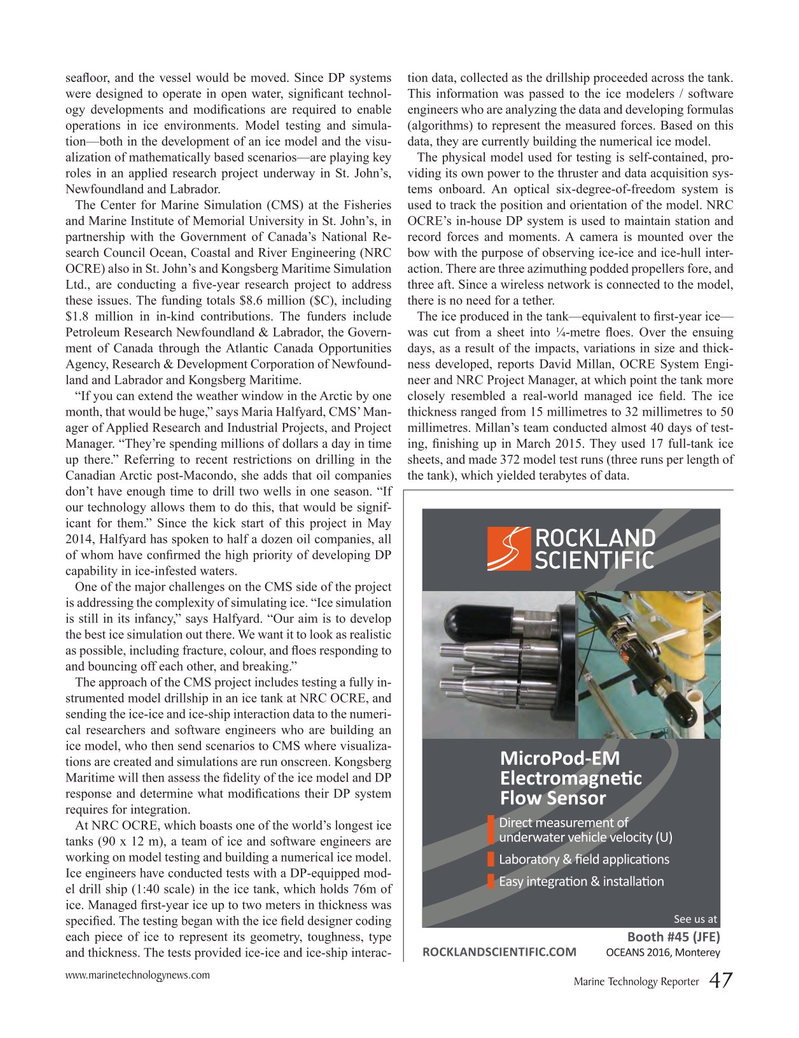
Page 47: of Marine Technology Magazine (September 2016)
Ocean Observation: Gliders, Buoys & Sub-Surface Networks
Read this page in Pdf, Flash or Html5 edition of September 2016 Marine Technology Magazine
sea? oor, and the vessel would be moved. Since DP systems tion data, collected as the drillship proceeded across the tank. were designed to operate in open water, signi? cant technol- This information was passed to the ice modelers / software ogy developments and modi? cations are required to enable engineers who are analyzing the data and developing formulas operations in ice environments. Model testing and simula- (algorithms) to represent the measured forces. Based on this tion—both in the development of an ice model and the visu- data, they are currently building the numerical ice model.
alization of mathematically based scenarios—are playing key The physical model used for testing is self-contained, pro- roles in an applied research project underway in St. John’s, viding its own power to the thruster and data acquisition sys-
Newfoundland and Labrador. tems onboard. An optical six-degree-of-freedom system is
The Center for Marine Simulation (CMS) at the Fisheries used to track the position and orientation of the model. NRC and Marine Institute of Memorial University in St. John’s, in OCRE’s in-house DP system is used to maintain station and partnership with the Government of Canada’s National Re- record forces and moments. A camera is mounted over the search Council Ocean, Coastal and River Engineering (NRC bow with the purpose of observing ice-ice and ice-hull inter-
OCRE) also in St. John’s and Kongsberg Maritime Simulation action. There are three azimuthing podded propellers fore, and
Ltd., are conducting a ? ve-year research project to address three aft. Since a wireless network is connected to the model, these issues. The funding totals $8.6 million ($C), including there is no need for a tether.
$1.8 million in in-kind contributions. The funders include The ice produced in the tank—equivalent to ? rst-year ice—
Petroleum Research Newfoundland & Labrador, the Govern- was cut from a sheet into ¼-metre ? oes. Over the ensuing ment of Canada through the Atlantic Canada Opportunities days, as a result of the impacts, variations in size and thick-
Agency, Research & Development Corporation of Newfound- ness developed, reports David Millan, OCRE System Engi- land and Labrador and Kongsberg Maritime. neer and NRC Project Manager, at which point the tank more “If you can extend the weather window in the Arctic by one closely resembled a real-world managed ice ? eld. The ice month, that would be huge,” says Maria Halfyard, CMS’ Man- thickness ranged from 15 millimetres to 32 millimetres to 50 ager of Applied Research and Industrial Projects, and Project millimetres. Millan’s team conducted almost 40 days of test-
Manager. “They’re spending millions of dollars a day in time ing, ? nishing up in March 2015. They used 17 full-tank ice up there.” Referring to recent restrictions on drilling in the sheets, and made 372 model test runs (three runs per length of
Canadian Arctic post-Macondo, she adds that oil companies the tank), which yielded terabytes of data.
don’t have enough time to drill two wells in one season. “If our technology allows them to do this, that would be signif- icant for them.” Since the kick start of this project in May 2014, Halfyard has spoken to half a dozen oil companies, all of whom have con? rmed the high priority of developing DP capability in ice-infested waters.
One of the major challenges on the CMS side of the project is addressing the complexity of simulating ice. “Ice simulation is still in its infancy,” says Halfyard. “Our aim is to develop the best ice simulation out there. We want it to look as realistic as possible, including fracture, colour, and ? oes responding to and bouncing off each other, and breaking.”
The approach of the CMS project includes testing a fully in- strumented model drillship in an ice tank at NRC OCRE, and sending the ice-ice and ice-ship interaction data to the numeri- cal researchers and software engineers who are building an ice model, who then send scenarios to CMS where visualiza-
MicroPod-EM tions are created and simulations are run onscreen. Kongsberg
Maritime will then assess the ? delity of the ice model and DP uGÐl?ŽwAOYGOÐ response and determine what modi? cations their DP system
Flow Sensor requires for integration.
Direct measurement of
At NRC OCRE, which boasts one of the world’s longest ice underwater vehicle velocity (U) tanks (90 x 12 m), a team of ice and software engineers are working on model testing and building a numerical ice model. >AdŽ?AlŽ??TIGuEAÐÐusÐAOŽY?
Ice engineers have conducted tests with a DP-equipped mod-
A??sYlGO?AOŽYTsY?lAuuAOŽY el drill ship (1:40 scale) in the ice tank, which holds 76m of ice. Managed ? rst-year ice up to two meters in thickness was
See us at. speci? ed. The testing began with the ice ? eld designer coding each piece of ice to represent its geometry, toughness, type
Booth #45 (JFE)
OCEANS 2016, Monterey and thickness. The tests provided ice-ice and ice-ship interac- ROCKLANDSCIENTIFIC.COM www.marinetechnologynews.com
Marine Technology Reporter 47
MTR #7 (34-49).indd 47 8/26/2016 2:15:06 PM

 46
46

 48
48
